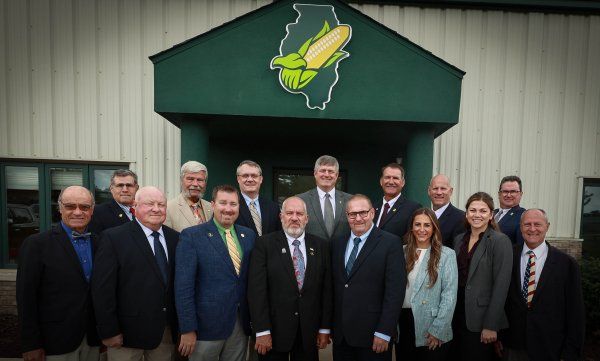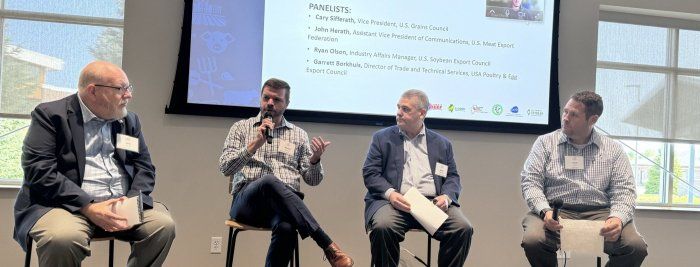Featured Article

September 25, 2024
Low water levels on the river system and a disruption in rail deliveries to Mexico are costing Illinois farmers this fall. Illinois corn farmers export more corn out of the state than any other state in the union. When unforeseeable circumstances impact the export of corn, Illinois corn farmers pay the price. As a five-year average, 49 percent of the corn grown in Illinois leaves the state destined for other markets. Most of that corn finds itself in another country to become livestock feed or ethanol. The vast majority of corn crosses the Illinois border on a barge or a rail car; Illinois farmers rely on their expansive river and rail transportation network to power international sales.

August 29, 2024
Jeff Scates, a farmer from Shawneetown, Illinois was elected by his peers to serve as Chairman of IL Corn Marketing Board (ICMB) for the 2024 – 2025 term. Jeff began farming at a young age and, after earning a bachelor’s degree in political science from Southern Illinois University, returned to his family farm, where he has been farming for 32 years. He and his family farms 15,000 acres of corn and soybeans with his father, uncles and cousins in Gallatin and White Counties in Illinois and Union County Kentucky.

August 29, 2024
Bipartisan collaboration is fundamental to IL Corn’s efforts to represent farmers in Springfield and Washington, D.C. IL Corn leaders were active this summer at the Republican National Convention (RNC) in July and the Democratic National Convention (DNC) in August. The two events marked a whirlwind of changes impacting America’s future. Farmer members met with key leaders on the House and Senate Agriculture Committees, state elected officials and attended agricultural events.

August 22, 2024
On Monday, Aug. 19, the U.S. Grains Council (Council) signed onto an industry letter comprised of 35 organizations that urged Canadian Prime Minister Trudeau to address concerns regarding a potential significant disruption to the North American supply chains and requesting he take action to ensure railroad operations continue to prevent serious damage to the Canadian and U.S. economies. A lockout or strike – that came today, Aug. 22 - could lead to shutdowns or slowdowns of rail-dependent facilities resulting in harmful consequences for Canadian and American agricultural producers, the agricultural industry and both domestic and global food security. Members of the U.S. Grains Council rely on freight rail transportation from the Canadian National Railway Company (CN) and Canadian Pacific Kansas City (CPKC). The letter stressed that: Trucking is not a viable option for many agricultural shippers due to their high-volume needs and the long distances for many of the movements. Agricultural facilities have no viable alternative transportation options to supply Canada’s international customers and the inability to cycle products through the supply chain could limit producers’ ability to deliver harvested crops. Delayed shipments impact costs not only for the value chain, but consumers, who will ultimately pay a higher price after the strike is resolved. Biofuels operations, in particular, require uninterrupted rail service. Interruptions quickly lead to storage capacity issues and restarting these facilities are complex, often causing domino disruptions for several weeks. The Council will keep members updated as soon as we hear something definitive. Complicating matters, BNSF , a U.S. railway that operates one of the largest railroad networks in North America, with about 32,500 route miles in 28 states, announced yesterday it shut down all operations to Mexico immediately and for the next 30 days due to ongoing congestion and service interruptions resulting in critical equipment being held in Mexico. Shuttles within BNSF loading facilities will continue to go through permitting to Mexico. However, customers with a trip falling within the 30-day window may cancel their shuttle free of charge or continue to reschedule with their marketing representative. BNSF is one of the largest railways with five important gateways to Mexico – at San Diego, El Paso, Eagle Pass, Laredo and Brownsville. The Council is concerned for more rail-dependent “just-in-time-delivery” customers located in Jalisco. This will compound existing pressure in the system and exacerbate ongoing delays for raw materials to Mexican customers. The Council is eager to find a solution for both sides of the border to increase capacity and continue trade flows.

August 22, 2024
IL Corn staff is actively reviewing the Final Herbicide Strategy released on August 20, 2024 . This strategy is part of the EPA's efforts to comply with a court ruling mandating alignment with the Endangered Species Act. Throughout this process, IL Corn has collaborated closely with the U.S. EPA and U.S. Fish and Wildlife Service to offer input and suggestions. While our review is ongoing, we're pleased to note several positive changes in the mitigation requirements for farmers within the final strategy. This review coincides with the public comment period for the Draft Insecticide Strategy, with comments due by September 23, 2024. For questions, more information, or to share your suggestions, please reach out to Megan Dwyer at mdwyer@ilcorn.org .

August 22, 2024
1. "In the 1970s, when our dad retired, my brother and I took over the farm, along with an employee who struggled with some performance issues. The employee quit unexpectedly during the busy season, forcing us to decide whether to hire someone new or manage on our own. Without the distraction of fixing their mistakes and directing their duties, we found our farm ran more efficiently, and we successfully operated with just the two of us. A few years later, a neighboring farm offered us the chance to double our operation, but we chose to stay focused on our own farm and volunteer leadership roles, avoiding the need to hire additional labor. Looking back with our accountant, it became clear that our decision to forgo expansion and labor costs was the right choice for our bottom line." Don Duvall, 4th Generation, Carmi, IL 2. "One of our best decisions on our family farm was building a grain handling system that could help keeping up with today’s yields rather than relying on a thirty-year-old system that required over half of our crop to be delivered to the elevators during harvest. Bad decisions: We just have to figure out how to see the positives and grow from them." Jeff Scates, 3rd Generation, Shawneetown, IL 3. "Best Decision: Switching the farm to 100% strip tillage. We (my dad and I) jumped in with both feet in 2018 and switched all corn acres to strip-till. All soybean acres followed in 2019. We have seen yields consistently approach 20% above our pre-strip-till yields in corn. Soybean yield bumped up a more modest »10%. There are two main reasons (as I see it) for the yield bump. First, the fertilizer is now placed under the row and is much more available to the crop. Secondly, our fall created strips have allowed us to get out in the field sooner in the spring to plant: gaining us a longer growing season. There are additional benefits beyond yield, such as the harvesting and planting trafficability of the soil and a reduced fertilizer (and application of fertilizer) cost." Luke Koffman, 3rd Generation, Tuscola, IL 4. "The best decision I made was getting involved with IL Corn and U.S. Grains Council . Before I got involved all I thought about was my own farm and situation. After becoming involved I had a bigger vision than just myself and I realized how much was going on without many farmers knowledge. I have visited several countries and met farmers and customers all over the world. Agriculture is a great industry to be in and I am humbled to play a small part in it." Mark Wilson, 7th Generation, Toulon, IL 5. "We had the opportunity to purchase 60 acres of ground at a reasonable price. At that same time there was worry about going into debt so I sold off 10 acres of ground to someone for a home site only to see the ground become more valuable and now it is a site that my wife would like to have back for a retirement setting. Best decision was following my father’s offer to farm the family farm. This gave me a chance to start my farming career which I loved and was fortunate to be able to raise 3 children with my wife of 47 years." Dale Haudrich, 3rd Generation, Waterloo, IL 6. "The best decision I made was to understand the soil biological function and how to use cover crops to enhance the bio-chemical and physical function of soil. The worst decision was the first year using cover crops the seed salesman said to plant 50 pounds per acre of ryegrass. He meant cereal rye and not annual ryegrass and we planted annual which made for a challenging spring to follow." David Kleinschmidt, 3rd Generation, Vandalia, IL 7. "An operational decision that I think was one of our best was adding semi-truck and trailers several years ago. They are expensive to purchase and maintain but have opened a lot of opportunities for when and where to deliver our grain. It has allowed us to take advantage of higher bids even if they are farther away. And every year more local elevators close, increasing the distance to deliver our grain. One of the worst decisions we’ve made in recent years was having a helicopter seed our cover crop over standing corn in late summer/early fall. The weather did not cooperate after seeding as we did not receive rain for at least 3 weeks. The cover crop had very poor germination and resulted in an extremely sparse stand. There was no chance for the cover crop to provide benefit. It was an expensive lesson for us to learn." Dan Parker, 4th Generation, Dwight, IL 8. "One of the best decisions was to have a bigger tractor with a cab and a loader. This made feeding cows in the winter easier, more stable for moving around big bales, good for pushing snow and all around safer in different weather conditions." Tom Mueller, 4th Generation, Taylor Ridge, IL Share your best or worst decision by emailing us !
Articles
2025
2024
2023
2022
2021
2020



